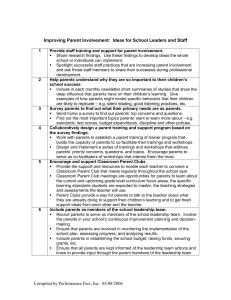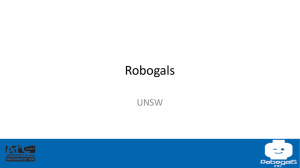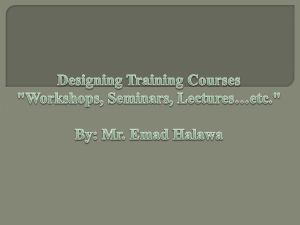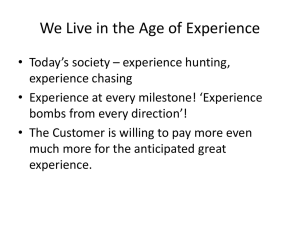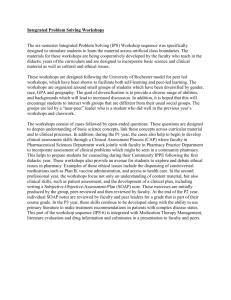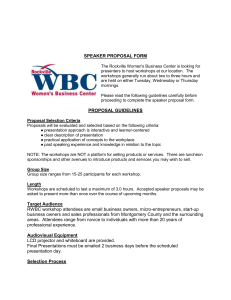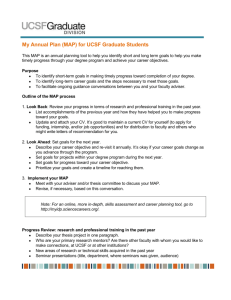Annex 4-1 - Results for Development Institute
advertisement
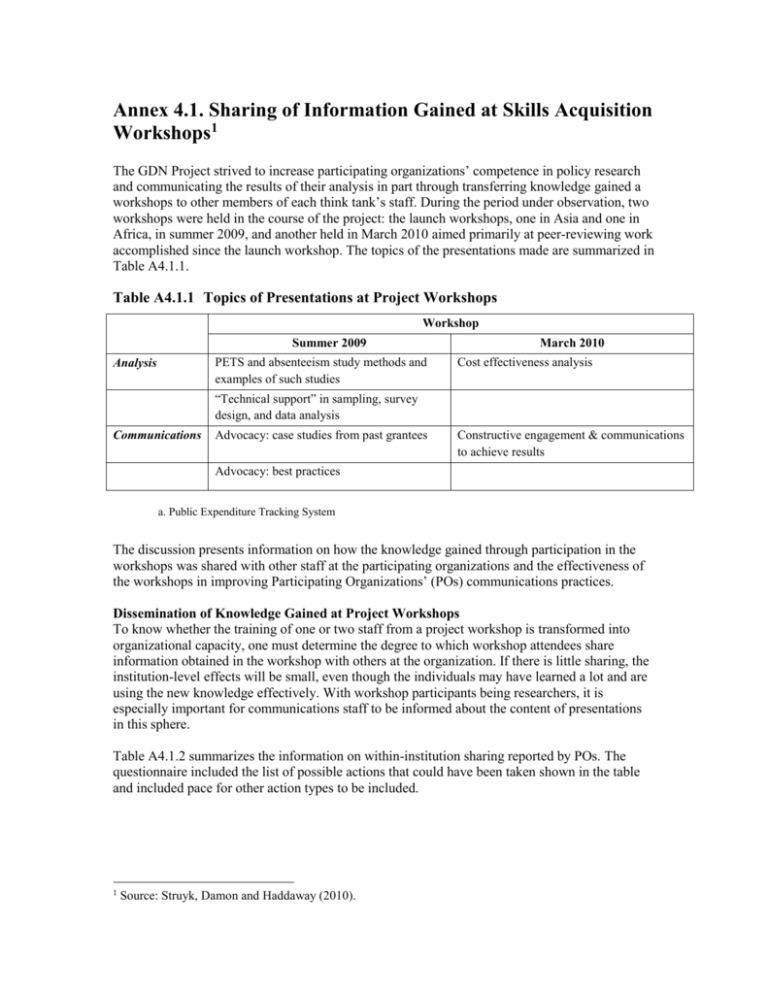
Annex 4.1. Sharing of Information Gained at Skills Acquisition Workshops1 The GDN Project strived to increase participating organizations’ competence in policy research and communicating the results of their analysis in part through transferring knowledge gained a workshops to other members of each think tank’s staff. During the period under observation, two workshops were held in the course of the project: the launch workshops, one in Asia and one in Africa, in summer 2009, and another held in March 2010 aimed primarily at peer-reviewing work accomplished since the launch workshop. The topics of the presentations made are summarized in Table A4.1.1. Table A4.1.1 Topics of Presentations at Project Workshops Area Workshop Summer 2009 PETS and absenteeism study methods and examples of such studies Analysis March 2010 Cost effectiveness analysis “Technical support” in sampling, survey design, and data analysis Communications Advocacy: case studies from past grantees Constructive engagement & communications to achieve results Advocacy: best practices a. Public Expenditure Tracking System The discussion presents information on how the knowledge gained through participation in the workshops was shared with other staff at the participating organizations and the effectiveness of the workshops in improving Participating Organizations’ (POs) communications practices. Dissemination of Knowledge Gained at Project Workshops To know whether the training of one or two staff from a project workshop is transformed into organizational capacity, one must determine the degree to which workshop attendees share information obtained in the workshop with others at the organization. If there is little sharing, the institution-level effects will be small, even though the individuals may have learned a lot and are using the new knowledge effectively. With workshop participants being researchers, it is especially important for communications staff to be informed about the content of presentations in this sphere. Table A4.1.2 summarizes the information on within-institution sharing reported by POs. The questionnaire included the list of possible actions that could have been taken shown in the table and included pace for other action types to be included. 1 Source: Struyk, Damon and Haddaway (2010). Table A4.1.2 Actions Undertaken After Project Workshops Percents Yes, we did this No, because staff know about this already No, for other reasons N · Distributed the materials obtained or a list of them to other researchers 86.7 6.7 6.7 15 · Led an informal discussion about program budgeting analyses 78.6 14.3 7.1 14 · Gave a formal presentation on program budgeting analyses 41.7 33.3 25.0 12 · Led an informal discussion on benefit incidence analyses 78.6 14.3 7.1 14 · Gave a formal presentation on benefit incidence analyses 53.8 30.8 15.4 13 · Gave materials on communications and impact strategies to your communications team 57.1 7.1 35.7 14 · Met with the communications team to explain what the sessions on communications strategies were about 53.3 0.0 46.7 15 · Other 100 0 0 2 · Distributed the materials obtained or a list of them to other researchers 92.3 0.0 7.7 13 · Led an informal discussion about cost effectiveness studies 91.7 8.3 0.0 12 · Gave a formal presentation on cost effectiveness studies 50.0 16.7 33.3 12 · Gave materials on communications best practices to your communications team 58.3 0.0 41.7 12 · Met with the communications team to explain what the sessions on communications techniques were about 58.3 0.0 41.7 12 · Other (specify) 100 0 0 1 May-09 – Launch workshop Analytic presentations Communications presentations Jan-10 – Review workshop Analytic presentations Communications The table shows a high degree of sharing the materials. Forty percent of POs reported having 3-5 sharing activities after the launch workshop and 60 percent after the review workshop. One-third reported 6 or more activities after the launch workshop.2 (Respondents were asked to indicate all activities they had undertaken; so there are multiple responses.) Substantial activity at nearly all POs is evident for the knowledge gained on research techniques at both workshops, ranging from sending around a list of the materials obtained to making formal presentations. The incidence of sharing materials and leading informal discussions is in the 78-87 percent range. The pattern indicates that organization-level benefits on the research side should accrue from participation in the Project. There was a substantial increase in sharing of research technique material between the first and second workshops. The pattern for the content of communications events at the workshops is quite different. For both workshops attendees from about half of the participating organizations passed on to the communications staff the materials from the “best practices in communications” session to the communications staff and met with them to review the material. Staff participating in the workshop who did not share the information from the analytic session fairly often said this was because other staff already was familiar with it. This is not the case for the communications information, where it appears that half of attendees just did not bother to share it. We can explore this point further by examining how PO senior managers perceived the change in their staffs’ advocacy communications knowledge resulting from the GDN presentations. As shown below, there is essentially a normal distribution of responses, with 73 percent of managers reporting modest to large increases. Table A4.1.3 illustrates a clear relationship between a modest or greater capacity increase and the number of transfer activities undertaken, i.e., managers perceive real improvement where greater effort was made by those attending the workshops to inform their colleagues charged with communications responsibilities. For the two workshops, those reporting negligible increases in capacity had a total 10 transfer actions, while those with modest increases and large increases had 44 and 37 actions, respectively. Table A4.1.3 Events Management Rating of Increased Communications Capacity from TAP How would you rate the increase in your organization’s knowledge of advocacy and communications abilities as a result of GDN presentations on these topics? Negligible increase 13.3 Modest increase 40.0 Large increase 33.3 Fundamental improvement 13.3 Further to the issue of effectiveness of the communications sessions, 60 percent of respondents named a change in communications practice in response to the following question: “Can you name a major change you organization made to your communications practices due to what you learned at the GDN events?” The questionnaire asked for a short summary of these changes. Examples include: “Address issues systematically, convince with reasons,” and “We learned about the pitfalls to avoid when granting interviews to media networks.” 2 Figures are not in the table.
